- August 1, 2022
- No Comment
- 13 minutes read
Why does my cat kick litter all over the place? 4 tips from cat experts – Buffalo News

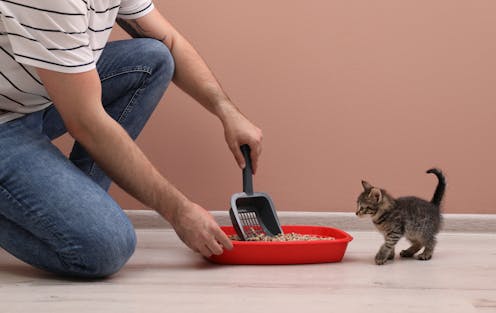 Shutterstock
Shutterstock
Does your cat kick litter all over the floor? What does this mean and how can you stop it?
Despite being skilled predators, cats are also mesopredators, meaning they are both predators and prey. Unlike apex predators at the top of the food chain with no natural predators, cats are in the middle, preying on smaller animals and being preyed upon by larger animals.
Because they are also a prey animal, cats developed instinctive behaviors to protect them from nearby predators. One of these behaviors is digging in the litter tray. Cats likely dig and cover their waste to hide their presence from visiting predators, who might be attracted by the scent.
Covering waste may also help cats to avoid parasites.
Read more: One in three people are infected with _Toxoplasma_ parasite – and the clue could be in our eyes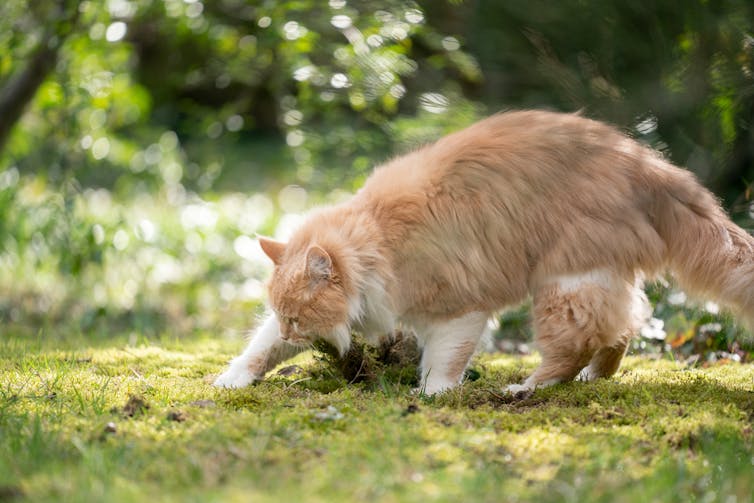 Cats likely dig and cover their waste to hide their presence from visiting predators. Shutterstock
Cats likely dig and cover their waste to hide their presence from visiting predators. Shutterstock
Cat waste also acts as an important communicator to other cats in the area, signaling how long ago a cat came through, a female that may be in heat or many other messages a cat may leave behind.
Which brings us to: what can you do about it, so your cat isn’t kicking litter everywhere?
In terms of changing the cat’s behavior, the short answer is: nothing. Digging is a natural and important behavior and trying to interrupt that may cause stress and confusion for your cat.
In fact, cats who dig in their litter box for longer probably like their litter box more and are less likely to have problems with pooing or weeing. Inappropriate pooing or weeing, especially outside the litter tray, can indicate urinary problems in cats. In a survey, of Australian cats around 20% pooed or weed outside the litter tray.
There are some simple solutions in setting up litter trays that can keep you and your cat happy — and litter in the tray.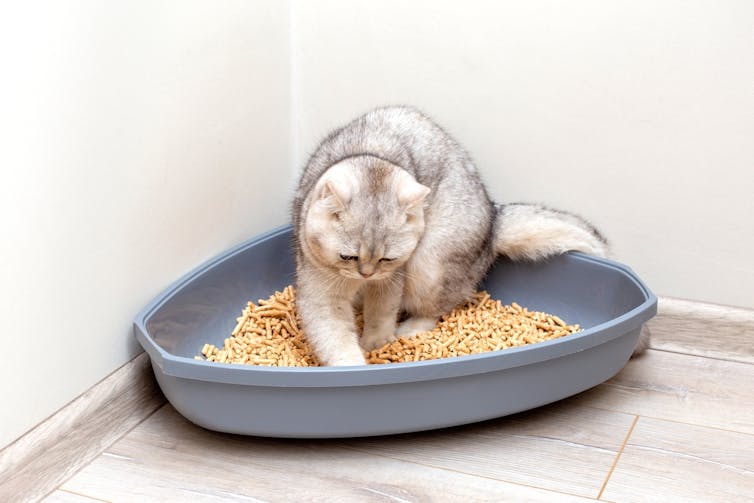 Digging is a natural and important behavior for cats. Shutterstock
Digging is a natural and important behavior for cats. Shutterstock
Have you ever had to pull a gross bit of food from the sink? Your cat may feel similarly about placing their paws in a dirty litter box.
Your cat’s hesitance to use their dirty litter tray may be leading them to hedge their bets, sticking to the edge, where the litter is less soaked, and kicking litter all over the floor.
The solution: Clean the tray regularly. Ideally, remove solid waste as it happens or once a day, and completely change over the litter every few days or before the top layer becomes soaked.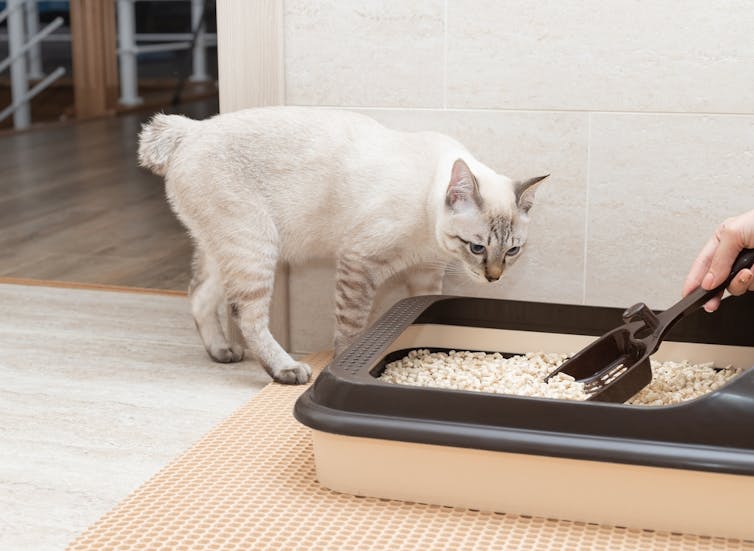 Clean your cat’s tray regularly. Shutterstock
Clean your cat’s tray regularly. Shutterstock
When it comes to filling the litter tray, more isn’t always better.
For cats with health issues such as arthritis, pain or restricted mobility, an overfilled litter box means trying to balance on an unstable mound of litter. And the more litter in the tray, the more litter that can end up on the floor.
Even cats without health issues may feel the need to dig deeper to find a stable surface to squat on. This means more litter on the floor both because of the increased volume and the cat’s extra efforts in digging.
The solution: Fill the tray with around 2-4cm (1-2 inches) of litter.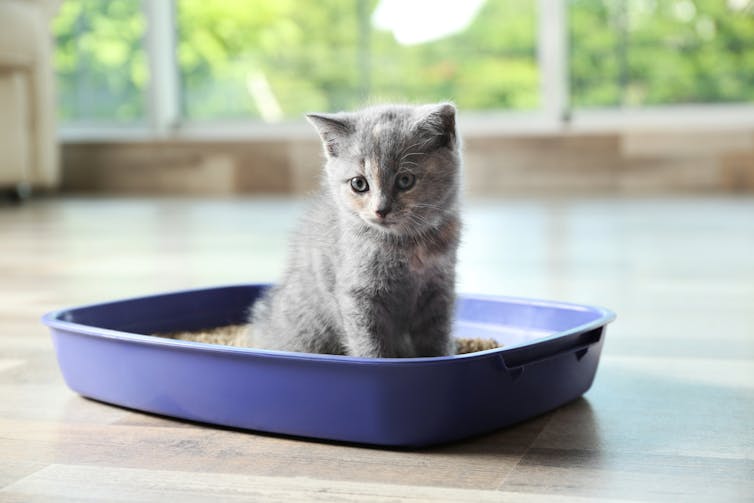 When it comes to filling the litter tray, more isn’t always better. Shutterstock
When it comes to filling the litter tray, more isn’t always better. Shutterstock
The general rule of thumb is one litter tray per cat plus one for the household. These should be placed around the house if possible, in places where your cats feel safe to go about their business.
Many litter boxes are too small. If your cat is constantly kicking litter around, try investing in a larger box. A covered litter box may be a solution, but cats are individuals too and some don’t like being cooped up when trying to poo or wee.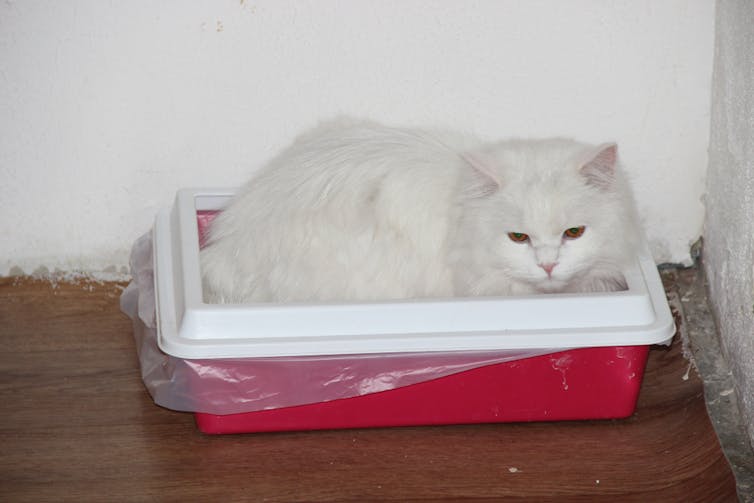 Many litter trays are too small. Shutterstock
Many litter trays are too small. Shutterstock
You can find trays with higher sides or an additional edge that hangs over and stops some of the litter from flying.
If you can’t find something large enough or suitable, you can try making your own from something as simple as a plastic washing tub.
A great way to work out which type of litter box your cat prefers is to place two different types side by side and see which one they use the most.
If it’s not any of the above, it’s possible your cat just has a real zest for kicking up litter.
If the litter on the floor is a real problem for you, you can place specific mats around the litter or in the doorway to the room(s) where the litter is.
These mats help to collect the litter as the cat walks over them, containing that kicked up mess to a smaller area and stopping litter from being tracked into your other rooms.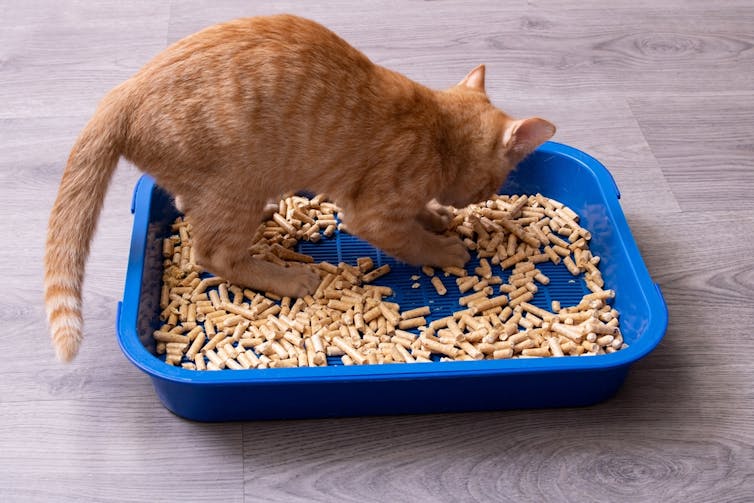 Maybe your cat just likes kicking up litter. Shutterstock
Maybe your cat just likes kicking up litter. Shutterstock
Toileting outside the litter box may indicate a behavioral or medical problem. If making the changes suggested above doesn’t help do consult your veterinarian.
If your cat is squatting frequently without much result, you should consult your veterinarian as quickly as possible.
Read more: Curious Kids: How can you tell if your cat is happy and likes you?
Susan Hazel is affiliated with the Dog & Cat Management Board of SA and RSPCA SA.
Julia Henning does not work for, consult, own shares in or receive funding from any company or organization that would benefit from this article, and has disclosed no relevant affiliations beyond their academic appointment.
This article is republished from The Conversation under a Creative Commons license.
One way to watch over your furry friends is to choose pet-friendly houseplants for your home.
While houseplants have the ability to bring life to a room and purify the air, a drawback is that many houseplants are toxic to animals. Here are 10 plants that add beauty to your home without worry.
First, keep in mind that while many plants are technically safe for cats and dogs, it’s best to eliminate temptation and place all houseplants out of reach. This will prevent possible tummy aches and digestive problems in your pets. If a pet ever does ingest a plant, make sure to watch them closely for signs of a negative reaction. Just because a plant is nontoxic for cats and dogs doesn’t mean ingesting it will make them feel good.
Photo by Sixteen Miles Out on Unsplash
Want pet-safe houseplants with blooms? Look no further than African violet. This versatile, hardworking houseplant is right at home with your pets. It comes in a range of purple hues, and it’s low maintenance and thrives without bright light.
The variegated gray-and-green leaves of this plant make it an attractive option for the home. It’s one of many great easy-care houseplants safe for pets.
Unlike their dangerous holiday counterpart amaryllis, Christmas cacti are not poisonous for pets like cats and dogs. The cactus may cause intestinal discomfort if ingested, but overall it’s a safer choice than many other festive plants.
This plant is named for the ease with which it can be divided and shared—so if you happen to receive such a gift, rest assured it’s safe for your cats and dogs. But beware, pets may be especially drawn to the fuzzy, crinkly leaves.
Indoor herb gardens are an easy, fun way to add fresh flavor to your cooking. But not all herbs are created equal when it comes to pet safety. Standards like lavender and oregano are off-limits, but pets are fine around basil, sage and thyme.
This quirky plant has blooms that resemble tubes of lipstick, and is safe for cats and dogs alike. A native of the tropics, it thrives in bright light and loves being outside in the warmer months.
This is the perfect solution for pet owners looking to add a small tree indoors. Safe for cats and dogs, it’s also great for green-thumb beginners.
This plant is perfect for adding a fun splash of pattern to miniature gardens, terrariums, mixed containers and more. Available in colors such as white and pink, it’s as versatile as it is whimsical.
Topping out at 6 to 8 inches, this plant is ideal for small spaces such as bookshelves and end tables. Its red, cream and green leaves curl up at night, giving it its name. What’s more, it’s one of the easiest houseplants you can grow.
Many of the most popular succulents — including hens and chicks, echeveria and rosettes — aren’t problematic. However, with so many varieties on the market, it’s best to research each individual plant.
Receive local adoptable pets PLUS updates for pet lovers in your inbox every week!
A Polish scientific institute has classified domestic cats as an “invasive alien species,” citing the damage they cause to birds and other wildlife.
Allergies develop when your pet’s immune system responds to an allergen. ManyPets outlines five types of pet allergies, where they come from, and how owners can manage them to keep their pets healthy and happy.
With offices bringing employees back and vacations in full swing, pet owners and people who work with dogs are dealing with pets’ separation anxiety.
Dogs with noise phobias often act out in response to thunderstorms. Here are tips from the American Kennel Club to help your dog weather the storm.
Forget red and blue states. We’re a pet nation, and a survey finds the U.S. evenly split — 25 feline-favoring and 25 canine-preferring states.
According to the American Veterinary Medical Association, about 40,000 pets in the U.S. die in home fires each year, mostly due to smoke inhalation.
A tangled web of industry funding and interests appears to have influenced the origin, data collection, and course of the FDA study of grain-free dog foods, according to internal FDA records.
Staying healthy and fit is also important for man’s best friend. For your dog’s diet, try these 10 superfoods that you can find in your own kitchen.
Get up-to-the-minute news sent straight to your device.

